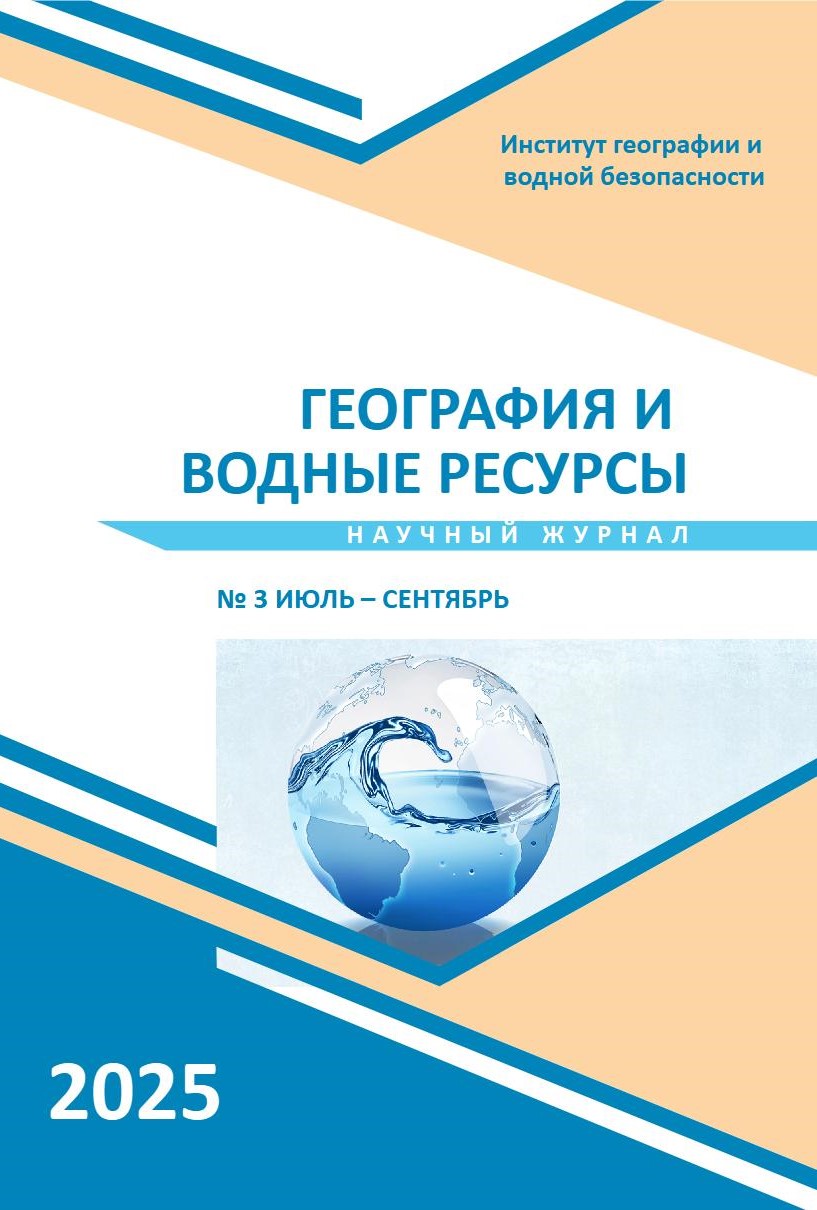MAPPING OF IRRIGATED LANDS IN AGRICULTURE USING GEOINFORMATION SYSTEMS
Main Article Content
Abstract
This paper provides an overview of research development using geographic information systems (GIS) for mapping irrigated agricultural lands. The development of modern society is impossible without the use of information technologies, since decision-making in any field requires reliable knowledge about the state of the environment, market trends, and other essential factors. In this regard, a number of important documents have been adopted in Kazakhstan to improve information exchange between individuals and legal entities through the creation of Internet and Intranet networks. The implementation of these processes should be based on geographic information systems. Kazakhstan ranks ninth in the world by territory, stretching 1,600 km from north to south and 3,000 km from east to west. Irrigated lands are used for the production of a wide range of agricultural products, including livestock farming. Infertile soils located along rivers are suitable for rice cultivation. Since overall soil fertility in the region is low, irrigation requires the application of nitrogen, phosphorus, and organic fertilizers.
Article Details
References
Restoration of damaged areas / P. N. Grishin, N. A. Mosienko and others. - Saratov: MGAU publishing house, 2011. - 236 p.
Protective afforestation / Pod ed. E. S. Pavlov. - Agropromizdat, 2012. – 263 p.
Guidelines for the design and cultivation of protective forest plantations on the lands of agricultural enterprises. - M.: Kolos, 2011. - 46 p.
Guidelines for the design and cultivation of protective forest plantations on the lands of agricultural enterprises. - M.: Kolos, 2011 - 335 p.
Forest reclamation with the basics of forestry. - M.: Ear. 2012. - 333 p.
Kolpakov V.V. Sukharev Agricultural reclamations/ Textbook for universities. - M.: Kolos, 2012 - 328 p.
Land reclamation and restoration workshop. Uch. allowance. / Sost. N.s. Yerkhov, L. P. Kozochkina, T. Orderly. - M.: GUZ, 2010.
Cheremisinov A. Yu., Revenkov A. I., Burlakov S. P. Restoration of damaged areas. Fly. allowance. - M.: 2010. - 80 p.
Chernysheva A. P. Workshop on forestry and protective forestry. - M.: Kolos, 2011. - 152 p.
Oldroyd D. R, Grapes, R. H (2008) Contributions to the history of geomorphology and Quaternary geology: an introduction:1–17.
Kleman J, Borgström I, Skelton A, Hall A (2016) Landscape evolution and landform inheritance in tectonically active regions: the case of the Southwestern Peloponnese, Greece. Zeitschrift Für Geomorphologie 60:171–193.
Castelltort S, Whittaker A, Vergés J (2015) Tectonics, sedimentation and surface processes: from the erosional engine to basin deposition. Earth Surface Processes and Landforms 40:1839–1846.
Zhang J.Y., Yin A., Liu W.C., Ding L., Xu X.M. (2016) First geomorphological and sedimentological evidence for the combined tectonic and climate control on Quaternary Yarlung river diversion in the eastern Himalaya. Lithosphere 8: 293–316.
Marshall J.A., Roering J.J., Gavin D.G., Granger D.E. (2017) Late Quaternary climatic controls on erosion rates and geomorphic processes in western Oregon, USA. GSA Bulletin 129:715–731.
Szabó J., Dávid L., Lóczy D. (2010) Anthropogenic geomorphology: a guide to man- made landforms. Springer Science & Business Media, Netherland.
Ellis E.C., Fuller D.Q., Kaplan J.O., Lutters W.G. (2013) Dating the Anthropocene: towards an empirical global history of human transformation of the terrestrial biosphere. Elementa: Science of the Anthropocene 1, p.000018, doi: 10.12952/journal.elementa.000018.
Tarolli P., Sofia G. (2016) Human topographic signatures and derived geomorphic processes across landscapes. Geomorphology 255:140–161.
Tarolli P. (2016) Humans and the Earth's surface. Earth Surface Processes and Landforms 41 (15):2301-2304.
Brown A.G., Tooth S., Bullard J.E., Thomas D., Chiverrell R.C., Plater A.J., Murton J., Thorndycraft V.R., Tarolli P., Rose J., Wainwright J., Downs P., Aalto R. (2017) The geomorphology of the Anthropocene: emergence, status and implications. Earth Surface Processes and Landforms 42:71–90.
Migoń P., Latocha A. (2018) Human impact and geomorphic change through time in the Sudetes, Central Europe. Quaternary International 470:194–206.
Goudie A. (2018) The human impact in geomorphology – 50 years of change. Geomorphology. https://doi.org/10.1016/j.geomorph.2018.12.002.
Tarolli P., Cao W., Sofia G., Evans D., Ellis E.C. (2019) From features to fingerprints: a general diagnostic framework for anthropogenic geomorphology. Progress in Physical Geography: Earth and Environment 43:95–128.
Curebal I., Efe R., Soykan A., Sonmez S. (2015) Impacts of anthropogenic factors on land degradation during the anthropocene in Turkey. J Environ Biol 36:51.
Borrelli P., Robinson D.A., Fleischer L.R., Lugato E., Ballabio C., Alewell C., Meusburger K., Modugno S., Schütt B., Ferro V., Bagarello V., Oost K.V., Montanarella L., Panagos P. (2017) An assessment of the global impact of 21st century land use change on soil erosion. Nature Communications 8 (1): 2013.
Tessler Z.D., Vörösmarty C.J., Grossberg M., Gladkova I., Aizenman H. (2016) A global empirical typology of anthropogenic drivers of environmental change in deltas. Sustainability Science 11:525–537.
Wang S., Fu B.J., Piao S., Lü Y., Ciais P., Feng X., Wang Y. (2016) Reduced sediment transport in the Yellow River due to anthropogenic changes. Nat Geosci 9:38
Poeppl R.E., Keesstra S.D., Maroulis J. (2017) A conceptual connectivity framework for understanding geomorphic change in human-impacted fluvial systems. Geomorphology 277:237–250.
Csima P. (2010) Urban development and anthropogenic geomorphology // Szabó J, Dávid L, Lóczy D (eds) Anthropogenic geomorphology. Springer, Dordrecht.
Sidle R.C., Ziegler A.D. (2012) The dilemma of mountain roads. Nature Geoscience 5 (7):437-438.
Penna D., Borga M., Aronica G.T., Brigandì G., Tarolli P. (2014) The influence of grid resolution on the prediction of natural and road-related shallow landslides. Hydrology and Earth System Sciences 18 (6):2127-2139.
Ramos-Scharrón C.E. (2018) Land disturbance effects of roads in runoff and sediment production on dry-tropical settings. Geoderma 310:107-119.
Hromyh V. V., Hromyh O. V. Cifrovye modeli rel'efa: uchebnoe posobie. – Tomsk, 2007 (in Russ.).
Molzhigitova D. K., Turganaliev S. R., Usenova A. N., Izbasar Z. G., Bisengalieva L. V. Assessment of land use by small farms in fruit and vegetable growing / Journal: Izdenister, netizheler - Research, results No. 1.2021 (89) IP. 149-156.
Ospanbaev Zh., Doszhanova A. S., Abdrazakov E., Kozhageldy E. Features of the formation of productivity of legendary crops under drip irrigation. / Journal: Research, results - Research, results No. 1.2021 (89) ISSN 2304-3334. P. 283-292.

